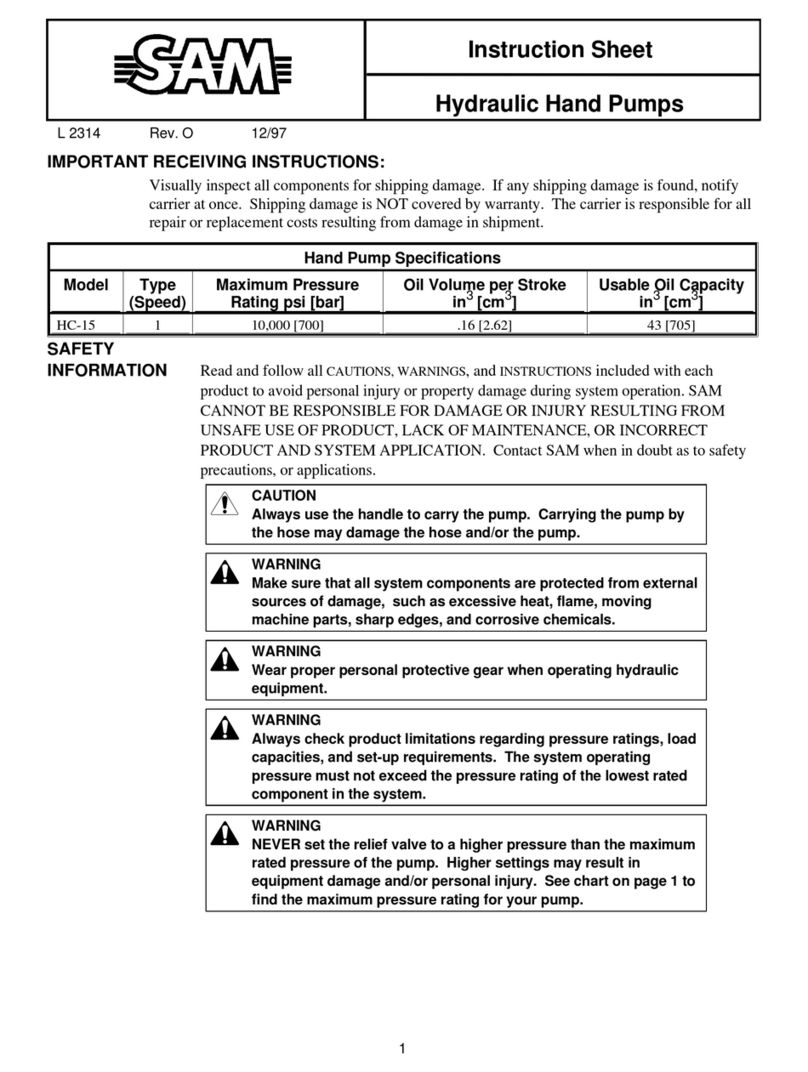
SP | Valves | Air Release Line
11. If there is a discharge from an open pipe into
the sump, the flow should be kept away from
the pump's suction pipe. This inflow usually
carries air down into the sump with the liquid.
Liquid with entrained air will increase priming
time and reduce pump efficiency. If the
discharge into the sump is close to the
suction pipe, install a baffle between the inflow
and suction pipe at a distance of at least six
times the diameter of suction pipe away from
the suction pipe. The baffle will allow the air to
escape from liquid before it is drawn into the
suction pipe.
12. The use of bell type increasers at the bottom
of the suction pipe is recommended to
reduce inlet velocity. If this can't be done, cut
the bottom of the suction pipe at a 45° angle
to avoid swirling of liquid.
VALVES
SAM Engineering (Pty) Ltd does not recommend
the use of a valve on the suction line EXCEPT:
a. In cases where positive suction heads are
present in the system or
b. Where it is possible for a positive head to
develop due to flooding conditions.
c. Sometimes it is advisable to have valves on
suction and discharge so that the pump may
be isolated during repair.
In any case, if suction valve is used, install with
stems in horizontal position to avoid air pockets.
1. If throttling valves are necessary in the
discharge line, use a valve size equivalent to
the largest pipe size in the line to minimise
friction loss. Never install a throttling valve in
the suction line.
2. Gate and check valves may be used on the
discharge side, but it is not necessary in low
discharge head applications.
3. It is recommended to use a throttling valve and
check valve in the discharge line to protect the
pump from excessive shock or water hammer
and reversed rotation when pump is stopped.
4. To minimise piping friction losses:
a. Keep discharge line as straight as possible.
b. Use the minimum number possible of
elbows and other pipe fittings.
c. Use long radius elbows and/or eccentric
reducers.
5. Do not terminate the discharge line at a level
lower than that of the liquid being pumped,
unless a siphon breaker is used in the
discharge line. Siphoning action may cause
damage to the pump.
6. If there is a high discharge head, slow
re-priming may be encountered requiring the
use of an air-venting device. If a discharge
check valve is used an air release line must be
incorporated between the discharge check
valve and pump to ensure priming.
7. If the system has a long discharge line it is
recommended to install a siphon breaker to
avoid siphoning out the liquid from pump
casing.
AIR RELEASE LINE
It is essential to allow the air to escape from the
discharge line to atmosphere during the initial
priming and re-priming cycle. In systems with high
discharge heads, it may be advisable to install an
air release line between the pump casing and
discharge check valve to aid their venting. The size
of the air release line is selected so that it does
not significantly affect the discharge capacity. You
may install an air release line through the filler
plug hole if necessary. However, the preferred
location is in the discharge line - between the
pump and the discharge check valve - as close to
the discharge check valve as possible.
We recommend the following line sizes for the
following ITT pumps.
3DTH & 4DTH -19mm Line
6ETH -25.4mm Line
8GTH & 10GTH -31.7mm Line
NOTE:
1. This line size may be increased or decreased
depending on application.
2. Direct the air release line back into the sump
(not into the pump suction line) leave the end
of the line open to atmosphere. Do not sub
merge into the liquid being pumped.
3. The air release line may clog, particularly if a
shut off valve is installed in the line and is
closed during operation. If this condition
occurs, either use a larger line or leave the shut
off valve open during pumping operation. To
aid in maintaining air release lines, fit them
with crosses instead of elbows.
4






























